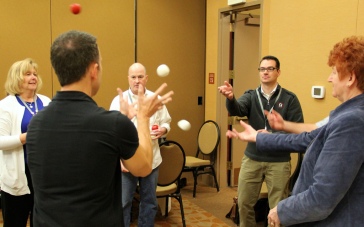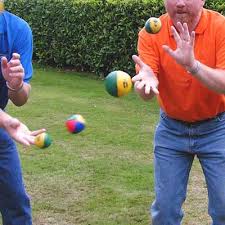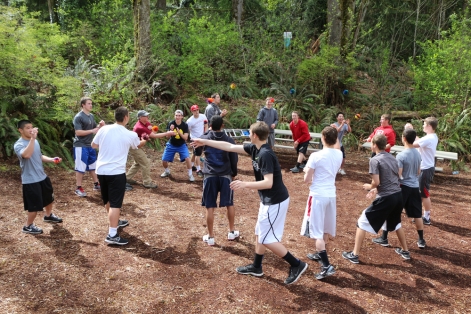
The most common thing that new facilitators (even people that have been at this for awhile) seem to struggle with is how to build a repertoire of activities that help them accomplish all that they need to do in a variety of situations and with many different kinds of groups and individuals. Given that reality, often new facilitators come into the field with the idea that they need to know 1000 activities in order to be effective. I don’t believe this is true. Good facilitators use what they know effectively and efficiently. They also choose activities for their “tool kit” that are adaptable and moldable to fit a range of participants and situations.
Over the next 3 installments I will share my top 3 activities along with ways to frame and adapt the activity for different situations, outcomes and groups. Please send along your comments and other ideas. I know that what I will share will certainly just scratch the surface of what is possible.
Activity #1: Group Juggle: This is my number one activity and can be used for anything from an ice breaker to a mid level problem solving initiative. It requires little in the way of props (a few balls or soft toys), but can get very elaborate with other props and metaphors (if you need to do that). If you think about it, the entire activity is an amazing metaphor for so many things—life, the challenges we face day to day, etc. With that in mind, it is so easy to find ways to take this from a simple name toss game to something much, much more. It also seems that every month or so I also encounter someone with a new way of using this activity. That’s exactly why this one is #1 on the list.
- Set-up (simple version): Have the group form a circle with some space (elbow length or arm’s length depending on the group and level of challenge) between participants. Show them the first object (a ball or soft toy) that is going to make its way around the group. Have several other objects ready to increase the difficulty and see below for variations that may require additional props.
- The Basic Activity: The basic set up involves tossing the object from participant to participant to establish a pattern. Everyone needs to remember the person they received the object from, and who they are tossing it too. The ball needs to go to everyone in the group and back to the person who started the pattern (usually the facilitator in the beginning). As the ball is tossed:
- Each participants says the name of the person they are throwing the ball to, the recipient should say “thank you_____”
- They will need to remember both the person they got the ball from and the person they throw the ball to in order to establish the pattern. This pattern does not change.
Practice with one ball until there is a bit of efficiency and everyone in the group has the pattern and the system down.

In the beginning, this is just a simple name game that requires a bit of focus. After a couple of successful rounds, here are some more things to do:
- Increase the number of objects
- Increase the number of objects and start them in different places in the group pattern.
- Give each person in the group an object and juggle them all in the established pattern.
- Have the direction of flow change on the command of “switch,” so that the person you are throwing to now becomes the person you are receiving from.
- Add additional commands, such as “slow motion,” “super slow motion,” and “speed demon” to increase the challenge.
- Have the group set goals based on:
- The number of objects they can juggle successfully at one time
- The number of times they can juggle the objects around the group without dropping one, etc.
- Have the group examine the key things that are necessary for success in this activity (i.e. focus, awareness, respect, etc.).

- Variations:
- “Random distraction objects:” Once a pattern is established, some goals have been accomplished and the group is in the flow of things, you can introduce another challenge of a random object (or even objects). I usually re-emphasize that the goal remains to juggle our original objects through the group in the same pattern with the same rules (i.e. saying the person’s name that you throw to, keeping all objects off the ground, etc.). The random object can go anywhere and to anyone at any time (I usually require that participants need to say the name of the person they are throwing the random object to before they throw it). It is a great metaphor for life distractions, and I have heard this object referred to as the “rumor ball,” “the video game ball,” etc. Its goal is to distract and remove our focus from the true goal (in this case, juggling our original objects in the pattern originally established). There are many obvious connections and a limitless amount of debrief opportunities depending on the group, it’s goals and related issues and situations.
- Multiple distractions: I have seen variations where backpacks, other balls, etc. were passed around the group circle as the original objects are being juggled and “random distraction objects” are also being dealt with by the group.
- “Object Metaphors:” Have the group take time to brainstorm a list of things they juggle in life. Name (even tag with a marker and tape) all of the objects OR allow the group to choose specific props that symbolize those things. You can even do the same with the random “distraction,” objects. Once this is completed, do a couple of rounds and evaluate how well things are going. Give the group a few minutes to plan ways to overcome the challenges that are present and come up with solutions.
- “Group Juggle Problem Solving Initiative:” Inform the group that the goal remains the same. I usually phrase it this way:
“The objects need to touch the hands of everyone in the group and, as before, you need to say the name of the person you are throwing the object to, and the objects need to end up back in the hands of the first person in our rotation. This is a timed activity”
There are many solutions to this problem. You’ll be amazed at how creative groups can get.
Please send me any other ideas you have for ways to use this activity or other variations you may have seen or discovered.
Have fun!
Join us on Pinterest Manito-wish Leadership for articles, resources, ideas and activities. Something added every day.
Please send along your success stories. We’d love to feature your program in future posts. Contact me directly at: mark.zanoni@manito-wish.org. We’d also love to hear your feedback and ideas. Thanks so much!
Mark Zanoni, Camp Manito-wish YMCA